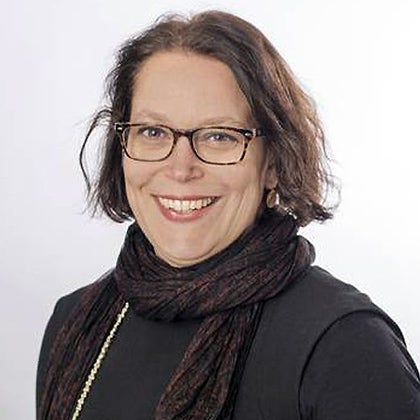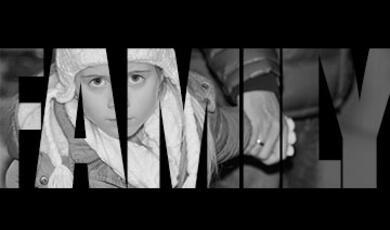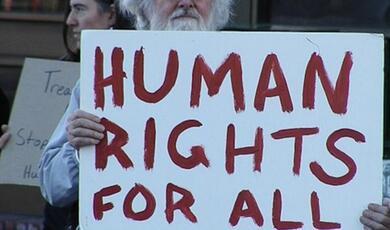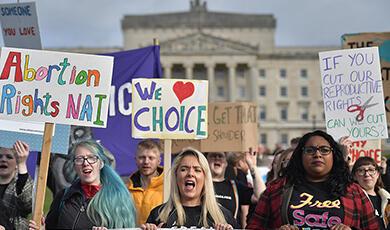Iran’s ‘Woman, Life, Freedom’ Movement
Share
- Details
- Text
- Audio
- Downloads
- Extra Reading
The death of the Kurdish woman, Jina Mahsa Amini, in September 2022 sparked the largest protests in Iran since the establishment of the Islamic Republic of Iran. The protests threaten the legitimacy of the Islamic Republic as a political system.
Beyond Iran, the protests have highlighted that Iranians reject gender-based, race-based, and religion-based violence. In addition to addressing the complexity of these protests, the lecture will place them in historical and regional context.
Download Text
Woman, Life, Freedom
Dr Shabnam Holliday
29 November 2023
Iran’s ‘Woman, Life, Freedom’ protests
This evening I am here to talk to you about Iran’s protests that began in September 2022 after the killing of the Kurdish Iranian woman Jina Mahsa Amini, whilst in custody for what the Islamic Republic of Iran considers improper hejab. As the protests developed and because of the popularity of the slogan, ‘Woman, Life, Freedom’, these protests have come to be known in terms of the Woman, Life, Freedom Uprising and movement.
My approach to these protests is from the perspective of an academic who works on the role ideas play in revolutionary and post-revolutionary situations. By this I mean situations where a change in political system looks like it might be apparent, or when an existing political system is sufficiently challenged that they use violence in response to protests or uprisings.
My approach is influenced by the importance of context.
Significantly, nothing happens in isolation. By this I mean no one lives in a vacuum. In other words, something happened before, and things happen at the same time in other places, or parts of the world. Nothing is ever just about domestic politics or that moment. Global trends, processes, and dynamics influence our actions on a daily basis. This could be the economy, the environment and climate change, and geopolitics, and often all at the same time.
It is this approach that influences the way I have interpreted the ‘Woman, Life, Freedom’ protests in Iran, and it is this approach that provides a structure for my talk this evening.
Today’s talk
- The protests as they appeared to us, outside of Iran, through social media. This will include some of the ideas that have come out of the protests and how they relate to political aspirations.
- Then I will show how these protests are intrinsically linked to global dynamics and geopolitics
- Finally, I will highlight how these protests and what they are calling for did not come out of the blue. There is a historical context.
The protests
- Most of what we know as the protests unfolded is from social media and specifically the platforms of Instagram, Twitter, and Facebook. There was a clear strategy from many Iranians inside Iran to get their experiences out to the rest of the world.
- Give a sense of how the protests as they appeared to those of us, outside of Iran. Alongside this I will give my own analysis regarding some of the ideas that have come out of the protests.
Jina tweets
- The protests were sparked by the death whilst in custody of the Kurdish 22-year-old woman, Jîna Mahsa Amini, after she was arrested for what the Islamic Republic of Iran considers improper hejab (headscarf).
- Significance of Kurdish identity.
- Compulsory hejab is one of the pillars of the ideology of the Islamic Republic of Iran, which was established after the revolution in 1979.
‘Woman, life, freedom’ in different languages
- Iran is a country of multiple peoples (mellat / ‘nation’), languages, religions.
- Slogan in the original Kurdish, and also Baloch, and Persian (Farsi). Also, common languages of Arabic and Azeri.
Tweets
- In response to Jina’s death whilst in custody, schoolgirls and women began removing their ru sari (headscarf), or hejab, and cutting their hair in solidarity. These acts were shared on social media.
- Importantly, boys and men came out in support.
Feminist Revolution
- Referred to as Iran’s first feminist uprising and by Kian Tajbaksh.[1]
- Situation in Iran that led to this situation referred to as gender apartheid by Haider Khezri.[2]
Shervin Hajipour
- As these protests developed, they were also about, as Asef Bayat puts it, the everyday.[3]
- Shervin Hajipour’ song is called Baraye, which means “because of,” “for,” “for the sake of”[4].
- Shervin wrote it in response to the tweets that Iranians posted after Jina’s death, all of which started with baraye.
- Intersectional protests.
Slogans
- Demanding a new revolution so that everyday lives could be lived.
- Explicit rejection of the Islamic Republic.
- Rejection of reforming the Islamic Republic, often referred to as Khatamism.
Global tweets
- Solidarity expressed through social media from outside Iran, globally.
Jin, Jiyan, Azadî
- Jina’s Kurdish identity and the Kurdish roots of the slogan Woman, Life, Freedom, have highlighted issues regarding Iran’s relationship with its different peoples.
- Article by Farangis Ghaderi and Ozlem Goner responds to these debates and refers to the extent to which commentators acknowledge these issues:
“Dismissing Jîna’s Kurdish identity, downplaying the systematic and structural oppression of ethnic minorities, and ignoring the origins of the now popularized chant, “Women, Life, Freedom,” risks fueling rifts, distrust, and resentment among Kurdish populations”.[5]
Violence
- The Islamic Republic’s response to protests has been extensive and horrific violence: chemical attacks, executions, arrests, and killings.
Charter of the minimum demands
“The banner of the revolutionary protests today raised by women, university students, high school students, teachers, workers, justice seekers, artists, queer people, writers and all oppressed Iranians across the country, from Kurdistan to Sistan and Baluchestan, attracting unprecedented international support, is a protest against misogyny and gender discrimination, interminable economic insecurity, the bondage of the labour force, poverty and misery and class oppression, and persecution along national and religious lines. It is a revolution against all the forms of religious and nonreligious dictatorship foisted upon us, the collective people of Iran, for over a century”.[6]
Charter of the minimum demands (cont’d)
“The immediate declaration of full equality between women and men in all political, economic, social, cultural and family respects; the unconditional abolition of laws and forms of discrimination based on gender and sexual orientations and identity, official recognition of the LGBTQIA+ community, decriminalisation of all sexual orientations and identities, and unconditional adherence to women’s rights to make decisions about their own bodies and affairs, and the prevention of acts of patriarchal control”. [7]
Charter of the minimum demands (cont’d)
“An end to environmental degradation, the implementation of decisive policies to revive environmental assets damaged over the past century, and the restitution to the public of all natural areas”. [8]
Geopolitics and international relations
- These protests are not just about domestic politics and a desire to change the political order inside Iran.
- International politics and dynamics, geopolitics are intrinsically linked to the protests.
- Three important points:
- Islamic Republic’s relationship with Kurdistan.
- Politics of sanctions.
- The Islamic Republic’s understanding of ‘anti-imperialism’.
Kurdistan
- Islamic Republic sees Kurds as security threat.
- 2018: Kurds constituted 45% of Iran’s political prisoners and that Kurds are seen as a security threat because of Iranian Kurdish dissidents in Iraq and Kurdish separatist.[9]
Politics of sanctions
- Sanctions in response to Iran’s nuclear programme, the nuclear programme itself, and regional politics are all part of the context for ideas from the democracy movement.
- Historically, a prevalent narrative was that EU & US sanctions were detrimental to organic democracy.[10]
- The Nuclear Deal was seen as a positive step for both regional stability and especially Iran-Israel relations, but also the first step to addressing human rights.
Politics of sanctions
- In 2018, Donald Trump rescinded the US’s involvement in the nuclear deal and US sanctions re-imposed.
- Sanctions were part of the context for the protests after the nuclear deal rescinded.
- Strong narrative now that is in favour of sanctions and against the nuclear deal because they are considered as legitimizing the Islamic Republic.
“The people of Iran ask the Western governments, especially the United States of America, to refrain from subscribing any type of agreements that will help the survival of the regime, as the Islamic Republic does not spend the funds for the welfare of the people, but on the contrary provides and buys more weapons, which in turn will cause more killings in Iran and the region.’’[11]
‘Anti-imperialism’
- The Islamic Republic sees itself as a leader of ‘anti-imperialism’ and as a leader in the Resistance from what is considered by the Islamic Republic as US hegemony, often referred to as ‘arrogant power’.
- Iran-Russia relations and involvement in Syria conflict and Ukraine conflict.
- The internal threat is securitized and reconstructed as the external threat.
Historical context
- Third and final part of the lecture.
- Importance of historical context, before and after the establishment of the Islamic Republic of Iran.
- Historical context on terms of gender rights, democracy activism, human rights activism, and most recent protests after the Iran nuclear deal in 2015 and The US withdrawal in 2018.
1979 International Women’s Day
- Protest against compulsory hejab law being introduced.
‘Khatamism’
- President between 1997 and 2005, popularly elected, put reforming the Islamic Republic as official state discourse.
- Political liberalisation in form of civil society and media proliferation.
- Sense of betrayal.
Women’s movement
- Re-emergence of a women’s press.
- Women well-versed in both the Quran and feminist ideology strove to re-conceptualise the position of women, for instance: Zanān Magazine, led Shahla Sherkat, and Farzāneh Women’s Studies Journal, led by Mahboubeh Abbasgholizadeh.[12]
- Between 2005 and 2009, several campaigns built on the Women’s Movement: One Million Signatures campaign, Meydān Zanān, Feminist School, and Focus on Iranian Women.[13]
2009 Protests
- Where is my vote campaign after 2009 presidential election when incumbent Mahmoud Ahmadinejad was re-elected.
- Demands: Reformism/Khatamism. But also, clear evidence of complete rejection of Reformism/Khatamism.[14]
- Use of violence against protestors: mass trials, harassment, arrests, exile.
Kurdish Women’s Movement
- Organized women’s movement among Kurds inside and outside of Iran.
- Context for ‘Jin, Jiyan, Azadi’ slogan.
Protests in Iran
- Conditions that led to the 2017-2020 protests were exacerbated with Raisi’s presidency.
- Bloody Aban / November 2019.
- Assassination of Major General Soleimani and downing of Ukraine flight PS752.
Narges Mohammadi
The Nobel Peace Prize 2023: "for her fight against the oppression of women in Iran and her fight to promote human rights and freedom for all”.
© Dr Shabnam Holliday 2023
References and Further Reading
- Abbasgholizadeh, M (2014) ‘“To Do Something We Are Unable to Do in Iran”: Cyberspace, the Public Sphere, and the Iranian Women’s Movement’,Signs, 39(4), pp. 831-40.
- Akbarzadeh S, Ahmed, Laoutides C & Gourlay W (2019) The Kurds in Iran: balancing national and ethnic identity in a securitised environment. Third World Quarterly, 40(6), pp. 1145-1162.
- Alemzadeh, M. (2023) Iran Protests and Patterns of State Repression. Iranian Studies 56, 557–561
- Bayat A (2022) A New Iran Has Been Born — A Global Iran, New Lines Magazine,
- https://newlinesmag.com/argument/a-new-iran-has-been-born-a-global-iran/?fbclid=IwAR1dW72eSZqMsaU3GzS7uq5YJ7IQ1wxksNT-0Iv0n7byzf9sCnd9smN6aAE
- Charter of minimum demands (2023) Available at: https://wpiran.org/english/wp-content/uploads/2023/02/Charter-of-the-Minimum-Demands-of-Irans-Independent-Trade-Unions-and-Civic-Organisations-English-15-Feb-2023.pdf
- Ebadi S (2022) Dr Shirin Ebadi addresses UN Security Council, Available at: https://www.nobelwomensinitiative.org/dr_shirin_ebadi_addresses_un_security_council
- Ghaderi F and Goner O (2022) Why “Jina”: Erasure of Kurdish women and their politics from the uprisings in Iran, Available at: https://www.jadaliyya.com/Details/44560?fbclid=IwAR1Y1t6PcmWIB2X5WzlyZ0AhdH-OT7O1KQHS-wuyXEbnEVkkVwJGQoD6kng#
- Hajipour, Shervin (2022) Baraye, Available at: https://twitter.com/SBSNews/status/1577162527036825607
- Holliday, S J (2023) Beyond hegemony, world order as domination: Iran’s Green Movement and the nuclear sanctions regimes. International Relations
- Holliday S and Rivetti P (2016) ‘Divided We Stand? The Heterogeneous Political Identities of Iran’s 2009-2010 Uprisings’ in Shabnam Holliday and Philip Leech (eds.), Political Identities and Popular Uprisings in the Middle East. London: Rowman and Littlefield International, pp. 17-36
- Holliday S (2023) Iran’s ‘Woman, Life, Freedom’ Movement highlights global issues, https://blogs.lse.ac.uk/mec/2023/02/10/irans-woman-life-freedom-movement-highlights-global-issues/
- Honarbin-Holliday M (2013) Becoming Visible in Iran: Women in Contemporary Iranian Society, London: IB Tauris.
- Jafari, P. (2023) Revolt with a Revolutionary Perspective. Iranian Studies 56, 569-575
- Khezri H (2022) Unrest across Iran continues under state’s extreme gender apartheid, Available at: https://theconversation.com/unrest-across-iran-continues-under-states-extreme-gender-apartheid-183766
- Matin, K & Mahmoudi J (2023). The Kurdish Janus: The intersocietal construction of nations. Nations and Nationalism, 29(2), 718-733.
- Mohammadi N (2022). White Torture: Interviews with Iranian Women Prisoners. Simon and Schuster.
- Tajbaksh K (2022) Iran’s first feminist uprising, Available at: https://publicseminar.org/essays/irans-first-feminist-uprising/
© Dr Shabnam Holliday 2023
[1] Tajbaksh K (2022) Iran’s first feminist uprising, Available at: https://publicseminar.org/essays/irans-first-feminist-uprising/
[2] Khezri H (2022) Unrest across Iran continues under state’s extreme gender apartheid, Available at: https://theconversation.com/unrest-across-iran-continues-under-states-extreme-gender-apartheid-183766
[3] Bayat A (2022) A New Iran Has Been Born — A Global Iran, New Lines Magazine, Available at: https://newlinesmag.com/argument/a-new-iran-has-been-born-a-global-iran/?fbclid=IwAR1dW72eSZqMsaU3GzS7uq5YJ7IQ1wxksNT-0Iv0n7byzf9sCnd9smN6aAE
[4] Shervin Hajipour, Baraye, Available at: https://twitter.com/SBSNews/status/1577162527036825607
[5] Ghaderi F and Goner O (2022) Why “Jina”: Erasure of Kurdish women and their politics from the uprisings in Iran, Available at: https://www.jadaliyya.com/Details/44560?fbclid=IwAR1Y1t6PcmWIB2X5WzlyZ0AhdH-OT7O1KQHS-wuyXEbnEVkkVwJGQoD6kng#
[6] Charter of minimum demands (2023) Available at: https://wpiran.org/english/wp-content/uploads/2023/02/Charter-of-the-Minimum-Demands-of-Irans-Independent-Trade-Unions-and-Civic-Organisations-English-15-Feb-2023.pdf
[7] Charter of minimum demands (2023) Available at: https://wpiran.org/english/wp-content/uploads/2023/02/Charter-of-the-Minimum-Demands-of-Irans-Independent-Trade-Unions-and-Civic-Organisations-English-15-Feb-2023.pdf
[8] Charter of minimum demands (2023) Available at: https://wpiran.org/english/wp-content/uploads/2023/02/Charter-of-the-Minimum-Demands-of-Irans-Independent-Trade-Unions-and-Civic-Organisations-English-15-Feb-2023.pdf
[9] Akbarzadeh S, Ahmed , Laoutides C & Gourlay W (2019) The Kurds in Iran: balancing national and ethnic identity in a securitised environment. Third World Quarterly, 40(6), pp. 1145-1162.
[10] Holliday, S J (2023) Beyond hegemony, world order as domination: Iran’s Green Movement and the nuclear sanctions regimes. International Relations
[11] Ebadi S (2022) Dr Shirin Ebadi addresses UN Security Council, Available at: https://www.nobelwomensinitiative.org/dr_shirin_ebadi_addresses_un_security_council
[12] Honarbin-Holliday M (2013) Becoming Visible in Iran: Women in Contemporary Iranian Society, London: IB Tauris.
[13] Abbasgholizadeh, M (2014) ‘“To Do Something We Are Unable to Do in Iran”: Cyberspace, the Public Sphere, and the Iranian Women’s Movement’,Signs, 39(4), pp. 831-40.
[14] Holliday S and Rivetti P (2016) ‘Divided We Stand? The Heterogeneous Political Identities of Iran’s 2009-2010 (cont’d) Uprisings’ in Shabnam Holliday and Philip Leech (eds.), Political Identities and Popular Uprisings in the Middle East. London: Rowman and Littlefield International, pp. 17-36
References and Further Reading
- Abbasgholizadeh, M (2014) ‘“To Do Something We Are Unable to Do in Iran”: Cyberspace, the Public Sphere, and the Iranian Women’s Movement’,Signs, 39(4), pp. 831-40.
- Akbarzadeh S, Ahmed, Laoutides C & Gourlay W (2019) The Kurds in Iran: balancing national and ethnic identity in a securitised environment. Third World Quarterly, 40(6), pp. 1145-1162.
- Alemzadeh, M. (2023) Iran Protests and Patterns of State Repression. Iranian Studies 56, 557–561
- Bayat A (2022) A New Iran Has Been Born — A Global Iran, New Lines Magazine,
- https://newlinesmag.com/argument/a-new-iran-has-been-born-a-global-iran/?fbclid=IwAR1dW72eSZqMsaU3GzS7uq5YJ7IQ1wxksNT-0Iv0n7byzf9sCnd9smN6aAE
- Charter of minimum demands (2023) Available at: https://wpiran.org/english/wp-content/uploads/2023/02/Charter-of-the-Minimum-Demands-of-Irans-Independent-Trade-Unions-and-Civic-Organisations-English-15-Feb-2023.pdf
- Ebadi S (2022) Dr Shirin Ebadi addresses UN Security Council, Available at: https://www.nobelwomensinitiative.org/dr_shirin_ebadi_addresses_un_security_council
- Ghaderi F and Goner O (2022) Why “Jina”: Erasure of Kurdish women and their politics from the uprisings in Iran, Available at: https://www.jadaliyya.com/Details/44560?fbclid=IwAR1Y1t6PcmWIB2X5WzlyZ0AhdH-OT7O1KQHS-wuyXEbnEVkkVwJGQoD6kng#
- Hajipour, Shervin (2022) Baraye, Available at: https://twitter.com/SBSNews/status/1577162527036825607
- Holliday, S J (2023) Beyond hegemony, world order as domination: Iran’s Green Movement and the nuclear sanctions regimes. International Relations
- Holliday S and Rivetti P (2016) ‘Divided We Stand? The Heterogeneous Political Identities of Iran’s 2009-2010 Uprisings’ in Shabnam Holliday and Philip Leech (eds.), Political Identities and Popular Uprisings in the Middle East. London: Rowman and Littlefield International, pp. 17-36
- Holliday S (2023) Iran’s ‘Woman, Life, Freedom’ Movement highlights global issues, https://blogs.lse.ac.uk/mec/2023/02/10/irans-woman-life-freedom-movement-highlights-global-issues/
- Honarbin-Holliday M (2013) Becoming Visible in Iran: Women in Contemporary Iranian Society, London: IB Tauris.
- Jafari, P. (2023) Revolt with a Revolutionary Perspective. Iranian Studies 56, 569-575
- Khezri H (2022) Unrest across Iran continues under state’s extreme gender apartheid, Available at: https://theconversation.com/unrest-across-iran-continues-under-states-extreme-gender-apartheid-183766
- Matin, K & Mahmoudi J (2023). The Kurdish Janus: The intersocietal construction of nations. Nations and Nationalism, 29(2), 718-733.
- Mohammadi N (2022). White Torture: Interviews with Iranian Women Prisoners. Simon and Schuster.
- Tajbaksh K (2022) Iran’s first feminist uprising, Available at: https://publicseminar.org/essays/irans-first-feminist-uprising/
© Dr Shabnam Holliday 2023
[1] Tajbaksh K (2022) Iran’s first feminist uprising, Available at: https://publicseminar.org/essays/irans-first-feminist-uprising/
[2] Khezri H (2022) Unrest across Iran continues under state’s extreme gender apartheid, Available at: https://theconversation.com/unrest-across-iran-continues-under-states-extreme-gender-apartheid-183766
[3] Bayat A (2022) A New Iran Has Been Born — A Global Iran, New Lines Magazine, Available at: https://newlinesmag.com/argument/a-new-iran-has-been-born-a-global-iran/?fbclid=IwAR1dW72eSZqMsaU3GzS7uq5YJ7IQ1wxksNT-0Iv0n7byzf9sCnd9smN6aAE
[4] Shervin Hajipour, Baraye, Available at: https://twitter.com/SBSNews/status/1577162527036825607
[5] Ghaderi F and Goner O (2022) Why “Jina”: Erasure of Kurdish women and their politics from the uprisings in Iran, Available at: https://www.jadaliyya.com/Details/44560?fbclid=IwAR1Y1t6PcmWIB2X5WzlyZ0AhdH-OT7O1KQHS-wuyXEbnEVkkVwJGQoD6kng#
[6] Charter of minimum demands (2023) Available at: https://wpiran.org/english/wp-content/uploads/2023/02/Charter-of-the-Minimum-Demands-of-Irans-Independent-Trade-Unions-and-Civic-Organisations-English-15-Feb-2023.pdf
[7] Charter of minimum demands (2023) Available at: https://wpiran.org/english/wp-content/uploads/2023/02/Charter-of-the-Minimum-Demands-of-Irans-Independent-Trade-Unions-and-Civic-Organisations-English-15-Feb-2023.pdf
[8] Charter of minimum demands (2023) Available at: https://wpiran.org/english/wp-content/uploads/2023/02/Charter-of-the-Minimum-Demands-of-Irans-Independent-Trade-Unions-and-Civic-Organisations-English-15-Feb-2023.pdf
[9] Akbarzadeh S, Ahmed , Laoutides C & Gourlay W (2019) The Kurds in Iran: balancing national and ethnic identity in a securitised environment. Third World Quarterly, 40(6), pp. 1145-1162.
[10] Holliday, S J (2023) Beyond hegemony, world order as domination: Iran’s Green Movement and the nuclear sanctions regimes. International Relations
[11] Ebadi S (2022) Dr Shirin Ebadi addresses UN Security Council, Available at: https://www.nobelwomensinitiative.org/dr_shirin_ebadi_addresses_un_security_council
[12] Honarbin-Holliday M (2013) Becoming Visible in Iran: Women in Contemporary Iranian Society, London: IB Tauris.
[13] Abbasgholizadeh, M (2014) ‘“To Do Something We Are Unable to Do in Iran”: Cyberspace, the Public Sphere, and the Iranian Women’s Movement’,Signs, 39(4), pp. 831-40.
[14] Holliday S and Rivetti P (2016) ‘Divided We Stand? The Heterogeneous Political Identities of Iran’s 2009-2010 (cont’d) Uprisings’ in Shabnam Holliday and Philip Leech (eds.), Political Identities and Popular Uprisings in the Middle East. London: Rowman and Littlefield International, pp. 17-36
Part of:
This event was on Wed, 29 Nov 2023
Support Gresham
Gresham College has offered an outstanding education to the public free of charge for over 400 years. Today, Gresham College plays an important role in fostering a love of learning and a greater understanding of ourselves and the world around us. Your donation will help to widen our reach and to broaden our audience, allowing more people to benefit from a high-quality education from some of the brightest minds.


 Login
Login







